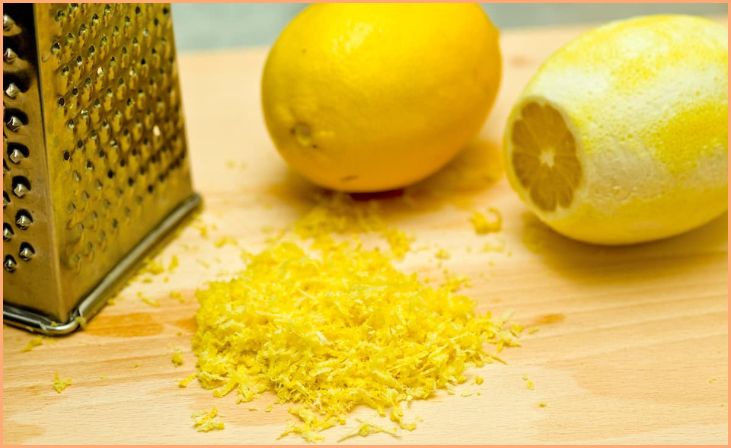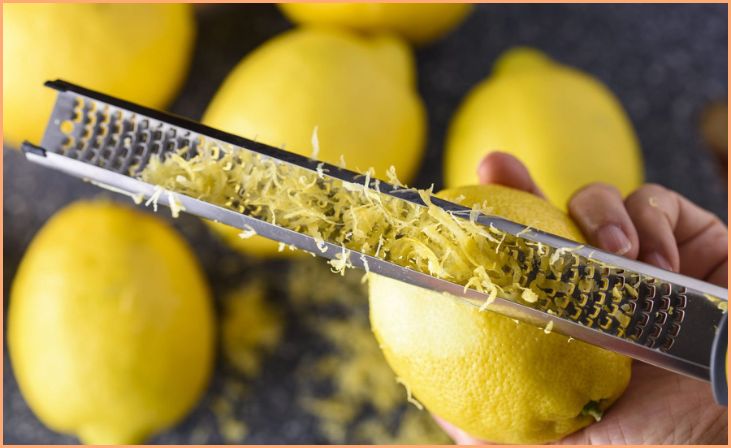Lemon Zest (or citrus peels) are used to put flavor into various recipes. Whether it’s dinner or dessert, recipes often require spices. There are so many recipes that call for lemon zest. Sweet or savory, lemon zest adds an extra zing to your food by providing a lemony flavor.
Lemon zest is commonly added to dishes such as baking, sauces, marinades, and salad dressings. In addition, larger pieces of zest work well to garnish cakes, pies, and most famously classic cocktails, such as the lemon drop martini. Today, I’ll show you how you can zest a lemon in different ways. Let’s get started!
What is Lemon Zest?
Lemon zest is obtained by scraping or cutting up the rind or peel of a lemon. Usually, only the very outermost part of the peel is considered lemon zest. Aromatic and full of citrus flavors, it is fragrant and delicious. Adding this to savory or sweet recipes can make them taste more gourmet!
How to Zest a lemon?
Before squeezing fresh lemon juice, why not grate them first? How to Zest Lemons:
If you use lemons for both the zest and the juice, grate the peel first and then squeeze the juice.
- First, wash the lemon
Clean the fruit with a sponge and warm soapy water before zesting a lemon. Rinse well and dry with a piece of cloth.
- Grating and Zesting Trick
Just as soon as removing the skin from lemons and other citrus fruits, try to remove only the thin outer skin or colored areas (leaving the pulp on the fruit). The white essential part gives your dish a bitter aftertaste. Use this fast and simple trick when you grate the lemon zest. wrap the zest side of the grater with a cover and grate the lemon over the plastic cover (be careful not to grate the bitter white center under the skin).
Most of the zest rests on the plastic cover and does not get caught in the grater hole. Simply peel off the plastic wrap and shake the zest against a plate.
- Set Aside Lemon Zest
Lemon peel is placed in a freezer bag and frozen until it becomes available. It’s very easy and very wonderful! You can also do this using Meyer lemon, orange, grapefruit, and lime zest. To make use of it, let the zest soften for a couple of minutes on the counter before putting it on the plate or bowl. Hence, It is not a chilled lump or chunk.
- Firmly Cover Zested Lemons
Lemon’s skin oil keeps fruits from drying, so no skin lemon requires protection. For this reason, firmly cover the zested lemon in a flexible cover prior to cooling or freezing.
For More- 9 Health Benefits of Consuming Hemp
Zest lemon with a Knife

Hold the Knife and the lemon in each hand—workaround the lemon, cutting into the fruit’s top and removing the peel in strips. Ensure you make the shallowest cut possible; avoid cutting too deeply.
The larger pieces of lemon can be chopped up or minced into smaller, thinner pieces after you have fully peeled them.
Zest lemon with Peeler
You can carefully remove layers of the yellow skin only by using a vegetable peeler. It’s important not to cut too deeply; you want to make the shallowest slice possible.
The peel should be minced into tiny pieces with the help of a chef’s Knife.
Zest lemon with a grater

You can make lemon zest using a box grater. The box grater’s smallest opening looks like tiny holes, so you should use that.
The grater should be placed over a cutting board or a clean surface. While holding the grater by its handle firmly in one hand, roll the lemon on the rough side of the grater to expose the pith underneath. Rotate the lemon as you go so that you can extract all of the zest.
Zest Lemon With A Microplane
This is one of the simplest ways to zest a lemon, but graters like Microplane are very sharp-edged devices and should be handled with care. Hold the grater with one hand and the lemon over the cutting board or a clean workbench with the other hand. Go in one direction and press the lemon against the rough surface of the grater to remove the colored parts of the fruit and expose the main part. softly spin the lemon to get as much Zest as possible from each fruit. The zest may stick to the bottom of the grater. Just tap to drop it and it will decline.
Zest Lemon With A Citrus Zester

The next way to zest the lemon is to make use of citrus zester. This device provides a long string of peel compared to the small pieces made by the Microplane. steps to peel a lemon with a Citrus zester:
- Place thin, razor-edged holes on one end of the citrus along the curve of the fruit.
- Gently press the fruit and pull it down to the other end.
- Do this process again until all the lemon zest is put to an end and only the pulp left.
Difference between Lemon Zest and Lemon Rind
The zest of a vegetable is the thin-colored part of the peel used to flavor food. For example, the lemon zester or grater will help you zest a lemon. However, citrus oil is found in it, and if you want to get the best result from removing lemon zest, it is best to utilize a zesting tool. In addition to garnishing, zests decorate dishes, cakes, cocktails, and many other dishes.
As for the Rindis, the thin, shiny layer just outside the fruit’s peel contains the aromatic oil glands that give the fruit its scent. Sometimes, it is referred to as lemon skin and used to simmer stews.
Also Read- How to Tell if Mushrooms are Bad? – Store Them For a Limited Time Only!
How to Preserve Lemon Zest?
Lemon zest can be stored in small jars in the refrigerator for up to two weeks. However, because lemon zest is so compact, I recommend freezing it in a tiny container to save space in the fridge.
However, Lemon zest holds the most flavor when used immediately after zesting or grating. For storing citrus zest later, freezing is your best option.
Conclusion
Lemon peels are usually discarded, but research shows that they may have a number of health benefits. They are rich in fiber, vitamins, and antioxidants that may support oral, immune, and cardiovascular health. It may even have anti-cancer properties.
So next time, if you are in the kitchen with lemon, never throw its peel, use it in a variety of dishes and enjoy the tang flavor of it.
FAQs
While any fine grater will work, a microplane or zester is recommended for the best results. It creates fine zest without the bitter white pith.
Gently press the lemon against the grater or zester to remove only the outer zest. Avoid pressing too hard, as it may include the bitter pith.
Yes, you can use a knife to carefully remove the zest in thin strips. However, a grater or zester is more efficient.







